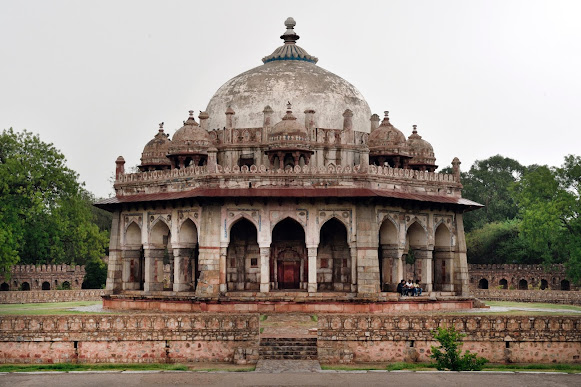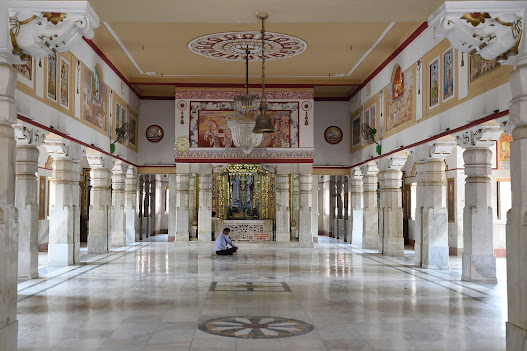Mathura
In Hinduism, Mathura is believed to be the birthplace of Krishna, which is located at the Krishna Janmasthan Temple Complex. It is one of the Sapta Puri, the seven cities considered holy by Hindus. The Kesava Deo Temple was built in ancient times on the site of Krishna's birthplace (an underground prison). Mathura was the capital of the kingdom of Surasena, ruled by Kansa, the maternal uncle of Krishna. Janmashtami is grandly celebrated in Mathura every year.
Mathura has been chosen as one of the heritage cities for the Heritage City Development and Augmentation Yojana scheme of Government of India. Actress turned political leader, Hema Malini is the sitting MP of holy constituency Mathura in Uttar Pradesh.
History
Mathura, which lies at the centre of the cultural region of Braj. has an ancient history and is also believed to be the homeland and birthplace of Krishna, who belonged to the Yadu dynasty. According to the Archaeological Survey of India plaque at the Mathura Museum, the city is mentioned in the oldest Indian epic, the Ramayana. In the epic, the Ikshwaku prince Shatrughna slays a demon called Lavanasura and claims the land. Afterwards, the place came to be known as Madhuvan as it was thickly wooded, then Madhupura and later Mathura. The most important pilgrimage site in Mathura was Katra ('market place'), now referred to as Krishna Janmasthan ('the birthplace of Krishna'). Excavations at the site revealed pottery and terracotta dating to the sixth century BCE, the remains of a large Buddhist complex, including a monastery called Yasha Vihara of the Gupta period, as well as Jain sculptures of the same era.
Ancient history
Archaeological excavations at Mathura show the gradual growth of a village into an important city during the Vedic age. The earliest period belonged to the Painted Grey Ware culture (1100–500 BCE), followed by the Northern Black Polished Ware culture (700–200 BCE). Mathura derived its importance as a center of trade due to its location where the northern trade route of the Indo-Gangetic Plain met with the routes to Malwa (central India) and the west coast. Archaeologists have discovered a fragment of Mathura red sandstone from Rakhigarhi - a site of Indus Valley civilization dated to 3rd millennium BCE - which was used as a grindstone; red sandstone was also a popular material for historic period sculptures.
By the 6th century BCE Mathura became the capital of the Surasena Kingdom.[16] The city was later ruled by the Maurya empire (4th to 2nd centuries BCE). Megasthenes, writing in the early 3rd century BCE, mentions Mathura as a great city under the name Μέθορα (Méthora). It seems it never was under the direct control of the following Shunga dynasty (2nd century BCE) as not a single archaeological remain of a Shunga presence were ever found in Mathura.
The Indo-Greeks may have taken control, direct or indirect, of Mathura some time between 180 BCE and 100 BCE, and remained so as late as 70 BCE according to the Yavanarajya inscription, which was found in Maghera, a town 17 kilometres (11 mi) from Mathura. The opening of the 3 line text of this inscription in Brahmi script translates as: "In the 116th year of the Yavana kingdom..."[20][21] or '"In the 116th year of Yavana hegemony" ("Yavanarajya") However, this also corresponds to the presence of the native Mitra dynasty of local rulers in Mathura, in approximately the same time frame (150 BCE—50 BCE), possibly pointing to a vassalage relationship with the Indo-Greeks.
How to Reach Mathura
How to Reach Mathura by Air
Agra Airport is the nearest airport to Mathura. However, as very few passenger flights operate here, the major nearest commercial airport of Mathura happens to be Indira Gandhi International Airport, Delhi. Visitors can board a flight from any Indian or international city till Delhi and then hire a bus, taxi or train to reach Mathura.
How to Reach Mathura by Rail
Mathura Junction is a major railhead on Central and Western Railways. Therefore visitors can avail train services from major cities including Kolkata, Delhi, Mumnbai, Indore, Agra, Bhopal, Gwalior, Varanasi, Lucknow to Mathura. One can also board local trains from Delhi, Bharatpur, Alwar and Agra till three other railway stations of Mathura.
How to Reach Mathura by Road
A good network of roadways connect Mathura to Delhi, Agra, Moradabad, Jaipur, Bikaner, Kolkata along with other small towns of UP and nearby states. Mathura is served by several state government buses along with private operators. Visitors can avail direct buses from places like Delhi, Agra, Alwar, Aligarh, Indore, Bhopal, Gwalior, Jabalpur, Jaipur, Udaipur, Ajmer, Chandigarh, Lucknow, Kanpur, Meerut, Haridwar etc
Top Delicacies from the Streets of Mathura & Vrindavan
1.Lassi
The lassi which is served in the earthen pot (kulhad), is a little different from what you have elsewhere. This lassi becomes a sinful affair due to the rich and thick layer of Malai and a heavy dose of dry fruit on the top.
2.Malpua
Malpua is a famous Indian dessert prepared from a fermented item, and is deeply fried and soaked in sugar syrup. This is one of the famous food of Mathura & Vrindavan; you will find it in every corner.
3.Rabri
Rabri is everyone’s favorite, including tourists as well as localities. Rabri is made by heating milk on a high flame. It does not require adding sugar, because the sweetness of the dish comes from milk. It can be eaten alone or with Malpua.
4.Samosa
You’ll have all the flavors of the food when you’re visiting Mathura & Vrindavan. The samosa here is made without onion and garlic, which will surely encourage you to have atleast one samosa. Samosa is served with green chutney or satvik aloo curry.
5.Kachori
Kachori in Mathura &Vrindavan is made with moong dal, and the scent of desi ghee drenched in it. There are varieties of kachoris served here, but the best one is with the filling of mawa and dry fruit. If you don’t like mawa and dry fruit, then need not to worry as lanes of Mathura & Vrindavan offer a variety of kachoris, and each one has its specialty.














0 comments